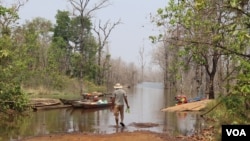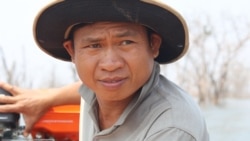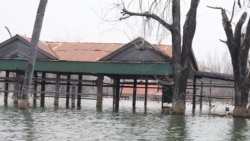Fut Kheun has been keeping a close watch on the water levels at the Sesan II reservoir, in the remote Srekor commune of Stung Treng province.
The ethnic Kreung villager is living close to the water at the reservoir, two years after ethnic minority communities were forced from their homes to make way for the 400MW Sesan Dam reservoir. Fut Kheun’s family is among the 60 that have rejected government compensation and have chosen to remain close to their ancestral lands.
Since then, Fut Kheun and other villagers have had to keep a constant eye on the water levels, attempting to restart their traditional practices, even though their familial lands and the graves of their ancestors now lay below hundreds of feet of water.
“It has been a few years and the water level doesn’t remain stable. It increases and decreases,” he said, adding this made it hard to find a suitable location to restart their community.
The Sesan II dam was highly controversial and a leaked government-commissioned study had warned of a devastating impact on the Mekong’s fisheries and ecosystem. Fish stocks were expected to drop 9.3 percent across the Mekong Basin, according to a study by the Proceedings of the National Academy of Sciences in the U.S.
At the time, Prime Minister Hun Sen and his government downplayed the environmental impact and approved the $816-million project.
The Chinese-funded dam, run by the Royal Group, has wreaked havoc on Lao and Kreung ethnic communities, who, two years later, are still attempting to restore their way of life. The villagers have kept watch of the waters to make sure that they can settle down in newly-created villages.
Villagers here said they are attempting to build a new community, comprising homes, a pagoda, and a site to pray to their ancestors and spirits. The communities follow animist-Buddhist traditions and villagers have already prayed for their ancestors to follow them to the new village site.
“We want to be together so it is easy to communicate and help each other when someone gets sick or passes away,” said Kheun, outside his under-construction house.
A majority of the Lao and Kreung indigenous minority villagers who lived in the villages, now submerged by the reservoir, accepted compensation from the government to move to new villages.
About 800 other families - all belonging to various hill communities from four villages near the Srepok and Sesan Rivers in Stung Treng Province - reluctantly accepted the government’s offer, after years of protesting in vain against the construction.
Villagers described the resettlement area as lacking in basic infrastructure and felt the government was not concerned about their well-being. Worse, the resettlement area is cut off from the river, a key source of fish, occupation and transportation for the villagers. The resettlement sites also lack any job opportunities, increasing desperation among families who agreed to move.
Khorng Orn is one of the villagers who decided to stay near his old village. He lost around five hectares of land to the dam project, and that he was living a life of “misery” now.
There was little opportunity to fish and their rice fields were flooded by the reservoir. Khorng Orn said he was lucky if he could catch three big fish a day, adding that villagers at the resettlement site were unable to fish because there were far from the river.
Environmental activists had warned of a heavy environmental and socio-economic impact beyond just the 33,000-hectare reservoir, because the dam is at the confluence of the Sesan and Srepok Rivers and would block fish migration from the Mekong River.
And while the last two years have been far from easy, Khorng Orn said he was attempting to start a new life at the makeshift village they were building.
“We will restart life here since we have built house. It will be wonderful,” said Khorng Orn.
Mom Saroeun, Stung Treng provincial governor could not be reached for comment.
Victor Jona, a spokesperson for the Ministry of Mines and Energy, said that a majority of villagers had accepted compensation packages, but the holdouts very adamant they wanted to remain close to their now-submerged villages.
“They have to move to resettlement place as the safe site,” he said. “If they don't move and there is a problem with the water level, that will be impact on them. They have to listen to us for safety.”
Back at the reservoir, Fut Kheun carefully steers his wooden, motorized longboat, expertly navigating treetops that stick out of the water.
He finds it hard to reconcile that his village is submerged below, but wants to use his experience to highlight the downsides of the country’s development push.
“I will keep this area as the evidence and for tourism, to let foreign tourists know how development causes people’s homes to be flooded and how they lose their property,” he said.







